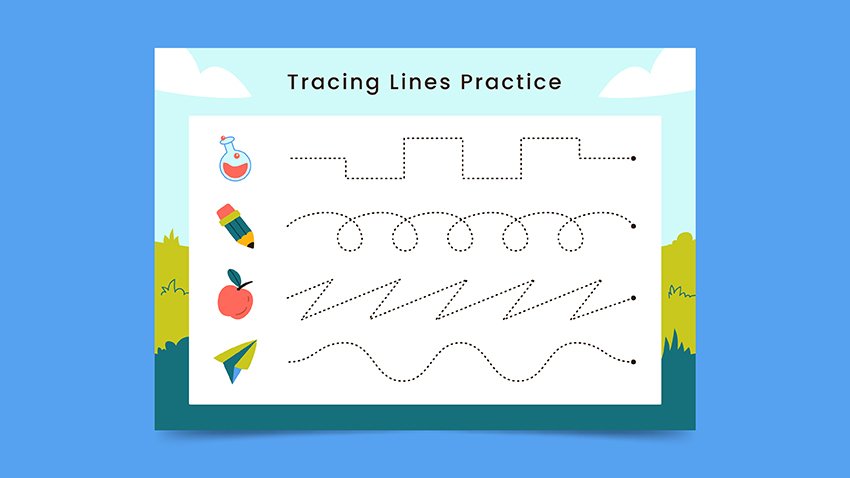



Straight, Slanting, and Curvy Lines: Easy Guide for Parents to Teach Kids

Learn fun and simple ways to teach your child standing line, sleeping line, slanting line activity, and curve lines for nursery. An easy guide for parents from all cities.




Let’s Talk About Lines
You know what’s funny? Something as simple as a line can feel so big when you’re teaching a toddler. One moment they’re scribbling all over the place. The next? You’re guiding their hand through a standing line.
And they pause. Look at you. Smile. Like it’s magic.
That’s the moment. The one when you realize they’re learning.
Teaching your child about lines is the first step in writing, drawing, and even thinking clearly. Lines are everywhere—letters, shapes, art. Let’s make it fun and simple for both of you.
Start with What They See
Kids learn best when they can connect lessons to real life. So before you even touch a pencil or worksheet, talk about lines they see every day.
Try this:
• Doors and windows? Those are standing lines.
• Tables and beds? Think sleeping lines.
• Kites or roofs? Hello, slanting lines.
• Rainbows and balloons? Perfect curved line shapes.
Once they see lines around them, learning becomes less abstract. And a lot more fun.
The Three Basics: Straight, Slanting, and Curvy
Let’s break them down.
1. Standing Line
This one’s simple. It's a vertical line. Just like when your child stands tall.
Draw a line from top to bottom. Say, “This is a standing line. Just like you when you’re ready for school!”
Activity idea?
Ask them to draw rain falling. One drop at a time. Straight down. Boom. Practice done.
2. Sleeping Line
This is a horizontal line. Like when your kid takes a nap.
Draw it left to right. “This is a sleeping line. It’s just like your bed.”
Here’s a fun sleeping line activity:
• Give them a row of stickers.
• Ask them to place each sticker along a drawn sleeping line.
• Watch their hand-eye coordination improve.
Learning? Happening. Quiet time? Also happening.
3. Slanting Line
Now it gets exciting. This line tilts. Like a slide in the park.
Say, “This is a slanting line. Like when you go whoosh down the slide.”
Want a slanting line activity idea?
• Make zigzag mountains using slanting lines.
• Ask your child to color them.
• It becomes art and learning in one shot.
Pro tip: Use colored pencils to make it more engaging.
Don’t Skip the Curves
Curves are the fun ones. They bring flow and movement. Letters like “C,” “O,” and “S”? All thanks to curves.
Introduce your child to curved line shapes by drawing things they love:
• Rainbows
• Smiley faces
• Balloons
Point and say, “These are curve lines for nursery learners. Just like you!”
Let them trace the curves with fingers first. No pressure. Just flow.
Why Lines Matter in Early Learning
At first, it might seem like a small lesson. But teaching lines builds the foundation for writing. Before your child writes “A,” they need to master standing lines and slanting lines. Before “O,” they need curve lines for nursery skills.
Here’s what they’re really learning:
• Fine motor control – holding a pencil with purpose
• Shape recognition – identifying patterns in letters and numbers
• Visual-spatial awareness – understanding direction, size, and placement
All through lines. Amazing, right?
Make Learning a Game
Don’t overthink it. Turn practice time into playtime. Here are a few easy games:
1. Line Hunt
Go around the house and spot different lines.
“Can you find a standing line?”
“Where’s a sleeping line in this room?”
2. Line Dance
Make lines on the floor using tape.
Ask your child to walk along them.
Standing. Sleeping. Slanting. Curvy.
3. Tracing Fun
Use sand, salt trays, or shaving foam.
Let them draw lines with fingers before moving to pencils.
Sensory + writing = double win.
Keep It Real. Keep It Simple.
I once saw a parent teaching her toddler with a ruler and complex worksheets. The kid looked like he was being asked to solve algebra.
That’s not the goal here.
The goal is to introduce lines in a way that feels like play.
Where mistakes are okay.
Where learning comes with laughter.
So next time your child scribbles circles and lines all over the wall? Pause before scolding. Maybe they’re just practicing their curve lines for nursery.
Tips to Make It Stick
If you want the lessons to last, here’s what helps:
• Short sessions. Keep it under 15 minutes.
• Daily touchpoints. A quick game or drawing every day is better than one big weekly session.
• Positive reinforcement. Celebrate every correct line. Even if it’s wobbly.
• Visual aids. Use flashcards or posters with arrows showing direction.
You’ll be surprised how fast they pick it up when it feels natural.
Lines Are Just the Beginning
Once your child understands standing line, sleeping line, slanting line activity, and curved line shapes, you’re ready for the next step—letters, shapes, and even early drawing.
They’ll start forming “L” using standing and sleeping lines.
They’ll draw triangles using slanting lines.
They’ll draw suns and smileys with curve lines for nursery.
That’s progress. That’s growth.
Final Thoughts
Your child doesn’t need expensive tools or fancy apps to learn lines.
What they really need is you—your time, your smile, and your patience.
So grab a pencil. Or a crayon.
Sit beside them.
Draw a line.
Then another.
Because every big journey begins with a simple stroke. A line.
Let’s help them draw it—together.
